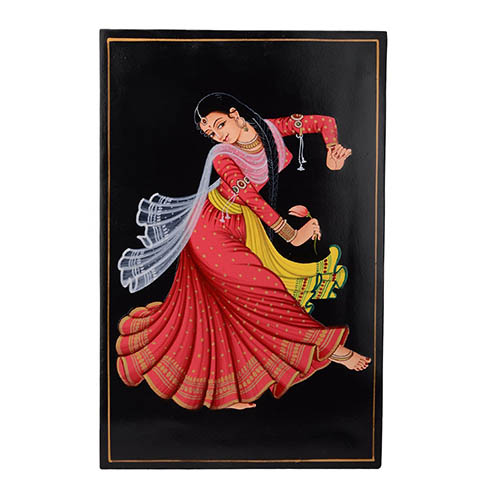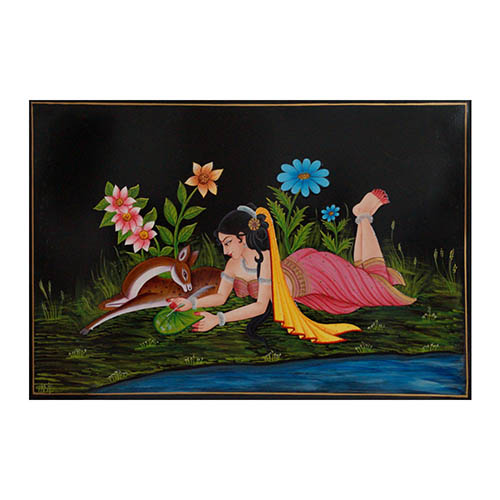Nirmal town is located amidst the dense forests of the newly created Nirmal district (erstwhile Adilabad District) in Telangana. This town is considered the gifted land of art and crafts, and is popular all over the country. The art and craft community of craftsmen living in Nirmal are also called as ‘Naqash’. This town is quite famous for the Nirmal paintings and toys. From the rustic ethos to the royal environment, from flora to fauna, an explicit array of expressions is portrayed in myriad colours and forms on Nirmal products. This art form named after its place of origin, Nirmal is being practiced by the 'Naqash' right from the 14th century.
Nirmal Paintings depict the traditional art scenes related to the Hindu epics of Ramayana and Mahabharata. These paintings were influenced by the Indian Schools of Art like Kangra, Ajanta as well as Mughal miniatures. The evolution of the Nirmal art and craft is also traced back to the old era of Kakatiya dynasty. The Mughal rulers were so enraptured by the Nirmal paintings, that they patronized this art greatly.
It is said that once the Nizam of Hyderabad was accorded a grand welcome when he visited Nirmal. The artisans decorated the venue and the seat of the Nizam in a grand manner with an intricately designed banana bud, believed to have been suspended over the Nizam’s seat. This was unfurled while there was a cascade of golden petals showered on him. This led to the Nizam patronizing the artisans, impressed by their skill. In the 1950's, Lady Hyder brought the artisans to Hyderabad and promoted this craft, under the Cottage Industries division in the Nizam’s government.
Over the last few decades, Nirmal work has been evolving in order to cater to new demands from the customers. There has been a transition from the painters of the epics to painting motifs in the old Indian school style. The Moghul miniatures are also crafted on soft white wood, called Puniki and these are eventually painted. The technique involves application of luppam on wood surface and then painting the precise design. The colors used in Nirmal paintings are mostly the familiar gold color. The paintings make use of organic colors produced naturally from the extracts of herbs, vegetable dye, gum, and minerals etc. The paintings depict scenes ranging from the grace of a dancer or a musician’s rhythm to birds, panoramic nature settings, and they fully captivate the attention of the viewer.
First the wood is cut into required size and a rectangular frame is made. The frame is smoothened using sand paper. The frame is also coated with several coats of luppam paint. Luppam Paint (NC patti) is coated on the rectangular shaped wood board for about 5 to 6 times. This paint absorbs the moisture from the wood and helps the wood to last for many years. After applying luppam paint, various colors are used for painting the background. Finally, the prepared wooden plank is joined to the frame. Usually, the board sizes are of 8/11, 17/11 and 24/16 dimensions.
The process in which Nirmal painting is done varies slightly from making toys. In this process, initially lacquering of the wood surface is done followed by painting according to the precise design. After painting, the plaque is given a coat of Duco paint using the desired background color. In earlier days, white wood of Tella Poniki tree was used as paint board for painting, which is fascinatingly outstanding. With changes over many years, the artisans introduced Indian teak wood due to its soft grain texture, strength, and lightweight and lifetime quality. Traditional designs are traced or drawn in chalk on smoothened wood or composition board and are painted in flat, bright colors and often touched up with gold and then varnished. Once the paintings are completed, clear spray is used on the frames for water resistance and luster. The Nirmal painting of Mughal miniatures is highly attractive. With aging, they acquire a special muted glow that is considered impeccable.
Nirmal town has become synonymous with exquisite painting all over the world and is a matter of pride for Telangana. Nirmal craftsmen also create lacquered furniture, boxes, bowls, large screens, trays, toys, and pictures, which are painted with finesse and attention to detail. Frames, shields and corporate gifts, name plates, Utility items constitute the range of products. There are paintings done even on the door, wall decoration etc. The paintings are gifted as souvenirs and are considered as proud possessions by lovers of art and art collectors. Painters and artists from all over India visit Nirmal to not only buy these masterpieces but also research the methodology in which the paintings are done, right from preparation of the canvass to the extraction of organic colors and style of painting.
Nirmal paintings are popular for many decades and the government of Telangana is making all efforts for promoting a global identity for the one-of- its-kind Nirmal Paintings and art works. The paintings are also exported to Australia, USA and UK through Golkonda handicrafts emporia (TS Govt Undertaking).





















